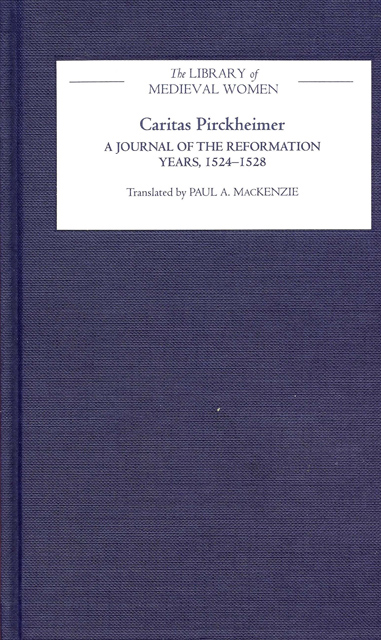Book contents
- Frontmatter
- Contents
- Acknowledgments
- Introduction: The Life and Times of Caritas Pirckheimer of Nürnberg
- A Note on the Manuscripts
- Text: A Journal of the Reformation Years 1524–1528
- Interpretive Essay: The Rebellion of the Abbess of St. Clare’s
- Annotated Bibliography
- Index
- Library of Medieval Women
Interpretive Essay: The Rebellion of the Abbess of St. Clare’s
Published online by Cambridge University Press: 18 March 2023
- Frontmatter
- Contents
- Acknowledgments
- Introduction: The Life and Times of Caritas Pirckheimer of Nürnberg
- A Note on the Manuscripts
- Text: A Journal of the Reformation Years 1524–1528
- Interpretive Essay: The Rebellion of the Abbess of St. Clare’s
- Annotated Bibliography
- Index
- Library of Medieval Women
Summary
The advent of the year 2000 was cause for celebration in the Franconian city of Nürnberg. The first documented mention of the city had occurred 950 years earlier on 16 July 1050, when Kaiser Heinrich III granted personal freedom to a young female surf by the name of Sigena. Thus, the history of the city was forever linked to the concept of personal freedom in general, and to that of the woman who symbolized that freedom in particular.
On the eve of the Reformation, Tetzel was promoting the sale of indulgences, a practice that had long been an acceptable activity. Indeed, Nürnberg's churches and monasteries had applied for and been granted indulgences many times. Just as the question of the validity of the Church's granting indulgences would occupy Luther and eventually lead to the Reformation, the larger theological issues such as that of faith versus good works, a concept championed by St. Paul and also taken up by Luther, as well as the right of an individual to follow the dictates of his or her conscience in matters of faith, would occupy Caritas Pirckheimer. Sigena was a simple, peasant girl. Caritas Pirckheimer, however, was educated, a member of one of Nürnberg’s most respected patrician families, and, more important, held the responsible position of abbess of St. Clare’s. What became of Sigena after she had obtained her freedom? There is no mention of her in any documents after this date. She disappears only to be used as a symbol whenever the need arises.
Caritas Pirckheimer might well have become another victim of historical neglect had she not shown the foresight to record in her Journal her “finest hour,” when she alone defended her right and that of the other members of St. Clare's to maintain a system of beliefs and a way of life whose very validity and legitimacy had been openly challenged.
Why is Caritas Pirckheimer important and in what way is her Journal significant? Thanks to her Journal we can conclude that Caritas Pirckheimer deserves our respect for her courageous stand for the right of a woman to freely choose her position in society. If a woman had chosen the cloistered life as a nun at St. Clare’s, she had a God-given right to obey her conscience.
- Type
- Chapter
- Information
- Caritas PirckheimerA Journal of the Reformation Years, 1524-1528, pp. 173 - 180Publisher: Boydell & BrewerPrint publication year: 2006



